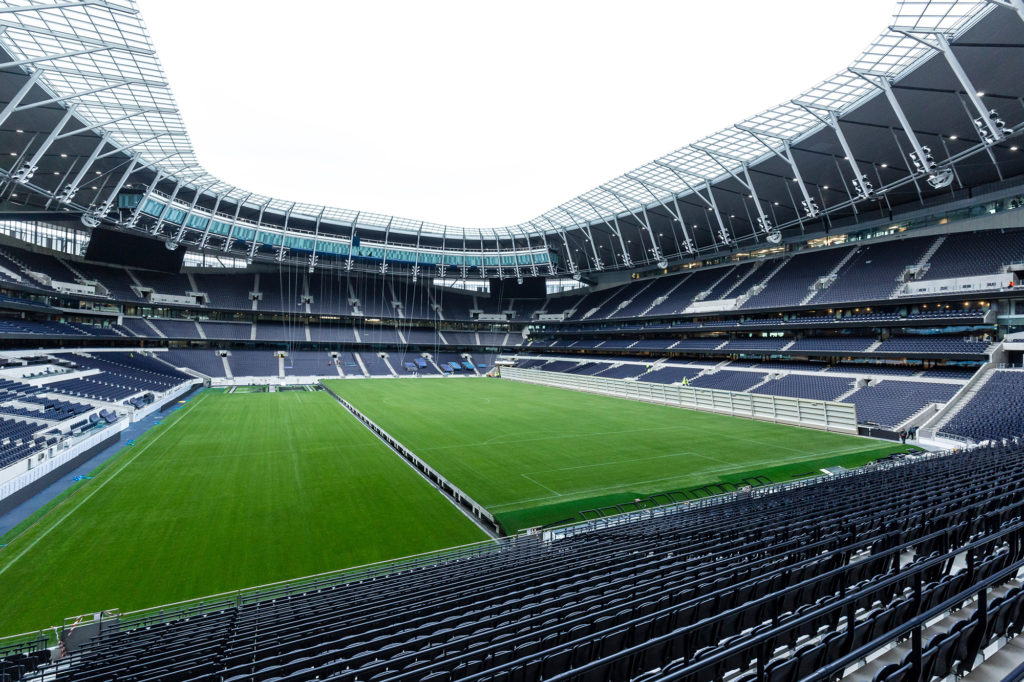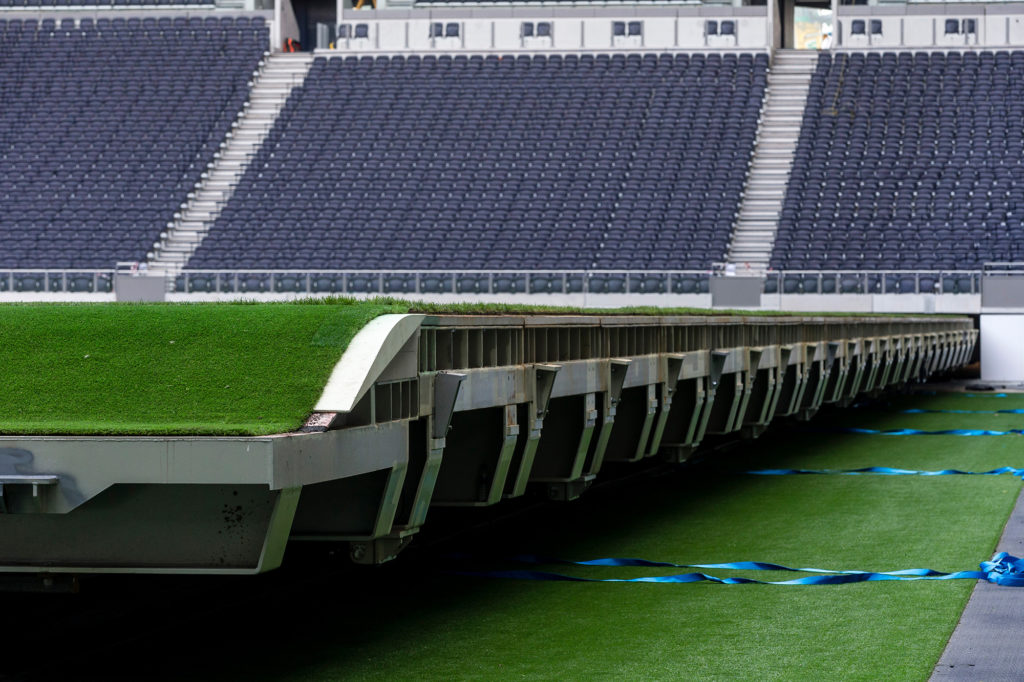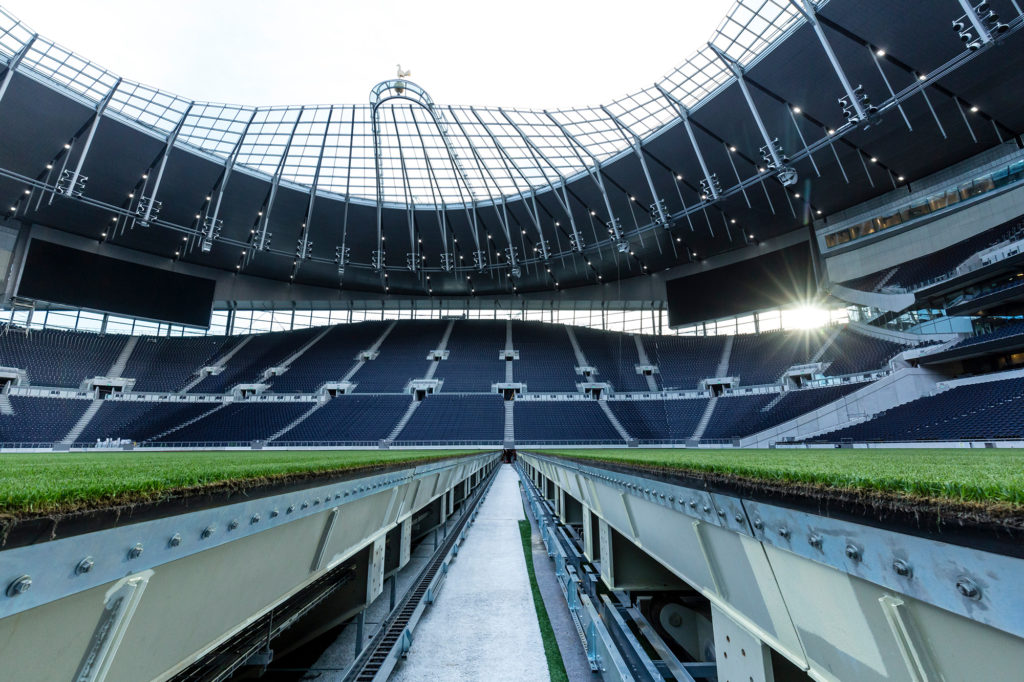
When the NFL begins a new chapter in London play with an Oakland Raiders-Chicago Bears game at Tottenham Hotspur Stadium, it will do so at a purpose-built multiuse stadium designed for equally high-end American football and British soccer experiences.
Tottenham Hotspur Stadium will host two NFL games this season: Oakland-Chicago today and Panthers-Buccaneers on Oct. 13. (Two other NFL London games are set for Wembley Stadium: Bengals at Rams on Oct. 27 and Texans at Jaguars on Nov. 3.) Originally scheduled to open last year, the $1.3-billion Tottenham Hotspur Stadium is set to host plenty of events, but the two marquee attractions will be Tottenham Hotspurs matches and at least two NFL games per season. The NFL is a financial partner in the project, contributing $12.8 million (£10 million) toward the cost of the new stadium.
With a capacity of 62,062, Tottenham Hotspur Stadium is certainly one of most opulent stadiums in the world, containing what’s called the longest bar in Europe at 213-plus feet, a Beavertown Brewery microbrewery and an abundance of food spaces and hospitality spots, including a restaurant run by a Michelin-starred chef.
Playing American football in a British soccer stadium isn’t new, but with the opening of Tottenham Hotspur Stadium, we have a purpose-built stadium with spaces configurable depending on the sport. The configurable spaces range from the playing field/pitch itself to group spaces that become extended broadcast facilities for NFL games. Designed by the London office of Populous with input from the American Populous offices, the new stadium is as much as a dedicated NFL facility as it is a Premier League home.
“The soccer team was so insistent that this had to be a well-done NFL stadium that every time we brought it up, they were accommodating,” said Brady Spencer, Senior Architect, Principal with Populous. “They said, we don’t want any reason as to why this doesn’t work.”
Spencer was hired to represent NFL interests in the design and construction of Tottenham Hotspur Stadium. His background includes serving as lead project architect for the Arrowhead Stadium renovations and project architect for four other NFL stadiums, including State Farm Stadium in Glendale, Arizona. That experience in Arizona with a moveable playing field was applied to what is perhaps the most noteworthy technical achievement at Tottenham Hotspur Stadium: a system allowing for a grass pitch for soccer and synthetic turf for American football.

A Moveable Feast
Tottenham matches are played on grass, but the NFL games will be played on a synthetic turf. In an unusual arrangement, the grass is moved off the base turf layer located a little more than five feet underneath. It’s an interesting solution to what is a huge challenge: how to provide optimal on-field performance for both sports.
The grass pitch sits in three steel trays each weighing more than 3,000 metric tons (or more than 6.6 million pounds). During a 25-minute process the trays separate and are moved to an underground storage area beneath the South Stand. (Why three steel trays? They must fit between the columns supporting the South Stand.) Once there the turf is serviced by grow lights, dehumidification and irrigation systems, and air ventilation, keeping it alive for up to 10 days. Removing the grass pitch exposes the synthetic turf used for NFL games.
There are multiple problems solved here. First, it preserves the best views of the gridiron in football mode. When American football has been played in the past in a soccer stadium, the first 10 or rows of stands have been closed off, as they were at pitch level and views were blocked by the multitude of players, coaches and equipment on the sidelines. By contrast, there are no such issues with a soccer pitch being at grandstand level: there are no players ringing the field, with the team seating traditionally located within recesses in the grandstand. With the football field more than five feet lower, those first rows in the grandstand become prime sports for watching the game, unobstructed by sideline activity.
“We [Populous] worked on State Farm Stadium [in Arizona], with the field tray there,” Spencer said. “This is a new iteration of that technology.”
The turf rolls out on steel rails embedded in concrete. But it’s not only the field that changes: The tunnel entrances raise up and down, as the departure of the turf creates a height difference.
The other issue addressed here: the quality of the pitch. Using synthetic turf for NFL play eliminates heavy wear and tear on the soccer pitch. It also allows for logos and markings to be added easily without affecting the soccer field.

Clubbing with the Broadcasters
A prime premium space for Tottenham Spurs matches is the H Club, located midfield with a great view of the action. But that’s also a space used in NFL stadiums for press boxes and, specifically, the booth location for the national broadcasters. Early on the decision was made to have it both ways, with the H Club fully operational as a hospitality area for Spurs matches and as a broadcast center for NFL games. The support features needed for today’s high-tech broadcasts is hidden behind walls during the Spurs matches and exposed for NFL games, while patio doors open to the bowl to give broadcasters a feel for the crowd.
The H Club won’t totally close down to accommodate the broadcast booth: the space offers five dining stations and a variety of experiences, including a Chef’s Table. For NFL games, glass partitions will give fans a look at the very glamorous behind-the-scenes production of a game broadcast.
“Right away we knew that would be a challenge,” Spencer said. “The soccer club wanted this to be their premium lounge experience. We worked with the club design to be converted to a broadcast booth, and that they don’t destroy the finishes in this ultra-high-end club.
“There are removable ceiling panels, and the millwork opens to wiring. It took a long time to detail and work through.”
One huge difference between Premier League soccer and NFL football: the much higher amount of support space needed for NFL games. People who have never been behind the scenes for pro football don’t realize what an enterprise it is, ranging from the team and coaches needs to the gameday production facilities. For Spurs matches, devoting a ton of space to these support spaces really makes no economic sense, even with the NFL as a big investor in the stadium project. And then there’s a space issue: the stadium footprint is a city block, with the new stadium occupying the same location as the Spurs’ former home, White Hart Lane, which had a capacity of 36,284. The stadium runs from edge to edge on the block.
So configurable spaces play a big role in the stadium design. Besides the approach used in the H Club / broadcast booth, a section of another hospitality space, the Sky Lounge in the West Stand (Stratus West), was designed to be configured for use as NFL coaches’ boxes and media spaces. Folding walls and partitions, complete with dedicated IT and technology, allow for the transformation.
One more broadcasting issue that came up early in the design process: the need to accommodate NFL camera needs in terms of locations. Soccer broadcasts tend to be dominated by fixed sweeping views of the pitch, punctuated by closeups. NFL broadcasts don’t have as many sweeping views of the field and focus on the line of scrimmage, with replays coming from a variety of angles. Those camera locations were part of the design very early in the process, Spencer said.
Team Spaces
Two NFL-quality locker rooms were built in addition to the football changing rooms, in the East Stand and northwest corner of the stadium. The home locker room, naturally, is larger and meets NFL requirements for a home team. Adjacent to this home locker room in the East Stand: a separate NFL press-conference room.
There were some adjustments as to how information is presented to the fans. The standard in Premier League stadiums isn’t a center-hung scoreboard, but rather four corner videoboards mostly conveying live game action. Those corner videoboards from Daktronics are indeed present in Tottenham Hotspur Stadium, but they’re larger than average and used to convey a wide range of information. (Speaking of signage: the stadium features plenty of digital wayfinding signage both inside and outside the stadium, sporting event-specific information.) Even the sound system needed to be beefed up for an NFL experience: there’s no music or commercials played during stoppages in the action for Premier League soccer, so the sound-system requirements are modest. Not so for an NFL game.
Defining the Fan Experience
For fans, an American football game and a European soccer match are run in entirely different ways. For Tottenham Spurs matches, food and drink are not allowed in the seating bowl, and when matches start, views from concourses are blocked by moveable curtains. That runs counter to the American experience, where today’s fan expects to see game action from the concourses during a beer and food run.
“The [British] stadiums love NFL games – they make more revenue from concessions, and fans can take food inside the stands themselves,” said Todd Barnes, Senior Event Architect and Senior Principal, Populous. “They make more sales from American football. Hotspurs fans are intense, flood out at halftime, and then head back to their seats.”
In addition, the pace of the match is different, said Barnes, whose experience as lead project manager on big events includes the MLB All-Star Game.
“The soccer fans will arrive an hour or less before the start of a match, while NFL fans make a day of it,” Barnes said. “Bars will stay open later for lingering fans, while soccer fans will leave immediately.
“In terms of the length of the game, NFL football is not as rigid. That surprises [Europeans] a little bit.”
And then there’s the mix in the stands. For soccer, away teams have a segregated area, literally walled off from home fans. Those away fans are escorted in by security escorts. That’s a big different from NFL, where you have two opposing teams but not the same level of dissention between them.

Game-Day Testing
With most stadium openings there are exhibition games or preseason matches to run the facility through its paces. Not so for Tottenham Hotspur Stadium. Although there have been many soccer matches played there since its April opening, the Oakland-Chicago game is the first NFL game on the schedule. Which means the technology will be tested on the fly.
“As stadium designers and architects, we’re used to the first event to be a concert or a preseason game. Not so here,” Spencer said. “We had to make really sure there are no bugs for this game, as this isn’t a preseason game. We’ve done extensive testing and run it through its full paces as if it was an NFL game.”
Photos courtesy Populous.
